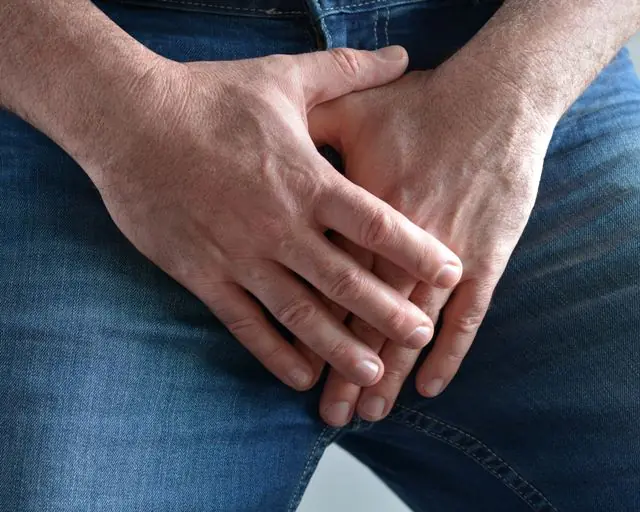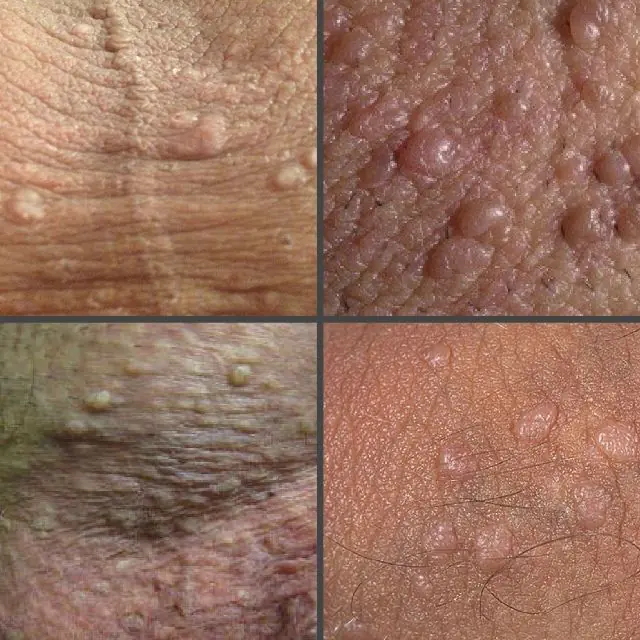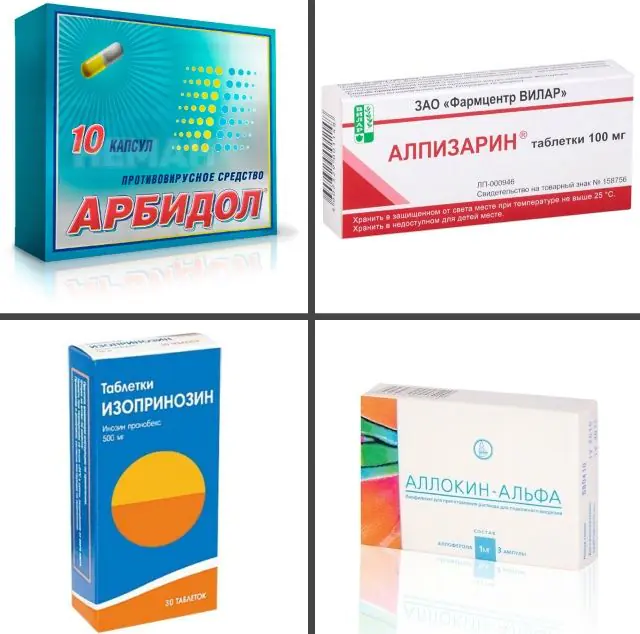
- Reasons for appearance
- What does papilloma on the scrotum look like?
- Treatment methods
- Radical removal
- Medicines
- Folk remedies
Papillomas on the scrotum are benign skin growths in the genital area. They are a manifestation of the activity of the human papillomavirus. In themselves, such growths are considered harmless, but under certain conditions they carry a huge risk of developing cancer. This is the main reason why doctors recommend removing them immediately. In this article, read about the causes of papillomas in men on the testicles, the main symptoms and types of formations, as well as modern treatment methods.
Causes of papilloma in men on the testicles

The appearance of papilloma on the scrotum and other parts of the body is preceded by infection with the human papilloma virus. This pathogen has a huge number of strains and is highly contagious, so the number of infected people is steadily growing. Not all existing species have a high degree of oncogenicity, but this is not a reason to leave the disease without treatment.
How is the human papillomavirus transmitted:
- Sexual contact. If papillomas begin to appear on men's eggs, then the most obvious cause of infection is considered to be intimate intimacy with the carrier of the virus. Moreover, this can be not only traditional sex between a man and a woman. The pathogen is transmitted through genital, anal, oral sex, and petting. This justifies the fact that people with increased sexual activity are at risk, for example, those who started having sex early, have several sexual partners, as well as representatives of both sexes with non-traditional orientation. In addition, you should not rely on condoms, because they only reduce the risk of infection, but do not eliminate it.
- Contact-household method. The pathogenic microorganism can also be transmitted through more harmless contact - with a kiss or handshake, during a massage or simple hug. The pathogen is contained in all biological fluids of the carrier - blood, saliva, urine, sweat, which can be left on objects of personal and public use. It continues its life activity for some time, so you can become infected by using the things that the carrier used. Places of increased danger are public baths, saunas, gyms, where high humidity prevails and sanitary and hygienic standards are not always met.
- At birth. There are cases where the disease was transmitted from mother to child during childbirth. Thus, papillomas on the testicles can appear even in a recently born boy.
- Self-infection. The method involves the involuntary transfer of the virus from one part of the body to another. Lack of personal hygiene culture, unhealed skin lesions - all this opens the way for the spread of the disease.
Once in a healthy body, the virus can hide for some time. The incubation period can be quite long - from 4 weeks to several months. The acute development of the disease - the beginning of the active growth of papilloma on the testicles in men and other parts of the body - begins at the moment when the human body weakens, losing its natural protective forces. The weaker the immune system, the faster the growths will grow.
Factors that significantly worsen immune defense include environmental pollution, bad habits, imbalanced nutrition, lack of an adequate work and rest schedule, lack of a culture of personal hygiene and sexual relations. Various diseases also play a significant role, for example, HIV, sexually transmitted diseases, inflammatory processes in the genitourinary system, hormonal imbalance, and disruption of the nervous and immune systems.
- See also the causes of warts on the genitals
What does papilloma on the scrotum look like?

Photo of papillomas on the scrotum
During the incubation period, it is impossible to suspect that you have HPV, because the disease occurs in a latent form, awaiting favorable conditions for activation. As soon as a decrease in a person’s immune status is observed, the course of regeneration processes is disrupted, the pathogen begins to actively integrate into weak epithelial cells and provoke the growth of benign neoplasms. This is how papillomas appear on the testicles in men. This is the main symptom of a dangerous virus.
Often, in the genital area, the growth rate of papillomas is much higher than in other parts of the body. This is justified by the fact that the skin here is thinner and more delicate. In addition, there is an increased risk of injury when wearing tight clothing. Here, increased sweating is observed and pathological microflora often develops.
Papillomas on the scrotum may look different depending on what strain of pathogen provoked their growth. They differ in color, shape, and fabric structure. In some cases, single growths appear, in others - multiple ones.
There are three options for the development of events depending on the type of pathogen and the individual characteristics of the organism:
- Neoplasms disappear under the influence of restored immunity;
- Papillomas remain in the same form in which they were found;
- The growths actively grow, change color, expanding the lesion to the male genital organ, the anal area, replacing healthy cells with atypical ones and provoking the development of the oncological process. This option is observed with a severe weakening of the immune defense and the absence of proper treatment.
Papillomas in men on the testicles can be classified as follows:
- Flat growths. They have a dark brown color and do not particularly stand out over the skin. They have a compacted structure, which allows them to be identified by palpation. They grow quite quickly and cause great discomfort.
- Condylomas acuminata. They can grow singly, but more often they form whole clusters in the shape of a cock's comb. The tips look pointed, but the growth is soft to the touch.
- Filiform papillomas. They grow in the form of a papilla, the tip of which can increase over time, forming a head. The structure of the fabrics is not rigid. This type of growth is quite easy to injure, but at the same time they are the easiest to remove.
- Buschke-Loewenstein condyloma. Often this type of papillomas is located not only on the scrotum, but also on the shaft of the penis. After inception, such a formation very quickly increases in size. Is a harbinger of cancer.
Along with the occurrence of benign neoplasms with different frequencies, other alarming signals of increased HPV activity may appear. Thus, infected areas can become inflamed when various infections occur, after hypothermia or as a result of injury, increased sweating and insufficient hygiene.
All this is often accompanied by the following symptoms:
- Development of an inflammatory process on the skin of the scrotum;
- Changes in the structure and color of the skin;
- The occurrence of pain and itching;
- Bleeding of growths, ulceration of the integument;
- Unpleasant sensations during intimacy;
- A decrease in local immunity with the subsequent development of dysfunction of the urinary and reproductive systems, disruption of the intestines and prostate gland, as well as the development of squamous cell carcinoma.
It is noteworthy that the presence of papillomas on the eggs in men provokes not only physical discomfort, but also the development of psycho-emotional disorders.
Methods for treating papillomas on the testicles in men
As soon as a man suspects that he has papillomas on his testicles, he should immediately contact a dermatologist, andrologist or venereologist for a visual examination and diagnostic procedures, because such growths may have an etiology different from HPV. Regardless of the reasons for the appearance of papilloma on the testicles in men, before starting treatment it is important to determine the strain of the virus, the viral load and assess the possible risks associated with the disease. For this purpose, blood and urine tests, oncocytological smears from the urethra, and a PCR test are prescribed. Only after receiving the results, the doctor prescribes drug therapy and recommends the most appropriate method for removing tumors in each particular case.
Radical removal of papillomas on the scrotum

Radical removal of papilloma on the scrotum is mandatory. And although such manipulations do not eliminate the cause of the disease—the human papillomavirus—they do significantly slow down its progression and reduce the risk of developing severe consequences.
There are many modern methods for the destruction of benign neoplasms on the genitals, in particular papillomas on the scrotum, among which the most popular are:
- Radio wave surgery. It is rightfully considered the most progressive and effective method. The impact is non-contact via high-frequency radio waves. During the procedure for removing papilloma on the scrotum, there is no bleeding or pain. The price of manipulation for minimal foci of growth is from 2000 rubles (from 700 hryvnia).
- Cryodestruction. The procedure involves quickly freezing the growth using liquid nitrogen. Under the influence of low temperatures, all biological processes in the scrotal papilloma stop, the cells are destroyed and fall off. The procedure does not cause pain. Cost - from 400 rubles (from 220 hryvnia).
- Laser therapy. The laser beam is quite accurate and, when performed correctly, does not injure healthy tissue. To avoid pain, local anesthesia is given. The manipulation involves burning out papillomas on the testicles of men, after which small, quickly healing burns remain. Price - from 1000 rubles (from 400 hryvnia).
- Surgical removal. It is least often prescribed for the removal of papilloma on the scrotum, because the procedure is considered radical. After the onset of anesthesia, the surgeon excises not only the growths, but also the tissue around it. Bleeding may begin during the process. The wounds take a long time to heal, they hurt. There is a risk of infection if dressings are performed incorrectly. Price - from 500 rubles (from 300 hryvnia).
Papilloma on the testicles in men can also be removed with the help of chemicals that, under the influence of acid, burn off the growths, forming a small chemical burn. This type of destruction can be carried out at home using special preparations purchased at the pharmacy. But due to the fact that this intimate area is very sensitive, and careless cauterization can harm important reproductive organs, it is better to entrust the procedure to a qualified physician.
Some of the above methods do not allow the tissue of the tumor to be taken for examination, but this may be necessary if there is a suspicion of cancer development. In this case, papilloma tissue on the scrotum is collected before the removal procedure.
During the rehabilitation period, it is recommended to refrain from sexual activity to reduce the risk of infection or damage to the wounds.Treatment of papilloma on the testicles with medications

In the photo are preparations for papillomas on the testicles
Doctors advocate timely and comprehensive treatment of testicular papillomas in men, because It is possible to prevent relapse of the disease after successful elimination of the external manifestations of the genital form of the human papillomavirus by simultaneously conducting antiviral and immunostimulating therapy. It is medications designed to fight HPV and strengthen the protective mechanisms of the human body that can suppress the activity of the pathogen, and therefore prevent the reappearance of papilloma on the testicles in men.
The wide list of medications used in the treatment of HPV includes the following:
- Allokin-alpha. Activates the killer cell system, promotes accelerated synthesis of interferon. Improves the functional abilities of cytotoxic lymphocytes. The drug has a prolonged effect. The course of treatment usually includes 6 injections. The cost is about 7,400 rubles (4,000 hryvnia).
- Alpizarin. It has high antiviral activity, therefore it effectively suppresses the virus that causes the growth of genital papillomas on the scrotum. It costs about 180 rubles or 120 hryvnia.
- Arbidol. Stimulates the synthesis of interferon, thereby increasing immune status. Affects the ability of the virus to integrate into cells, significantly reduces the population of the microorganism within the human body. Cost - from 150 rubles or 90 hryvnia.
- Acyclovir. It has a direct effect on the pathogen, blocks its reproduction, and therefore significantly reduces the viral load. An additional effect is strengthening the immune system. Price - within 150-200 rubles (90-120 hryvnia).
- Isoprinosine. The antiviral activity of the active substance is complemented by immunostimulating properties. The complex action allows you to block the growth of papillomas in men on the testicles, shaft of the penis and near the anus. The cost of the medicine in Russian pharmacies is 650 rubles, in Ukrainian pharmacies - 320 hryvnia.
- Cycloferon. Stimulates the production of immune cells, which helps increase the body's resistance to the activity of the virus. It is actively used for diagnosed HPV of various strains and the development of genital papillomas. The price of the drug is only 180 rubles or 130 hryvnia.
In the prescription form for the treatment of papillomas on the testicles in men, immunomodulatory drugs often appear, for example, Likopid, Galavit. They help rebuild the immune system so that it successfully copes with the human papillomavirus and makes the body less susceptible to other pathogens.
If the growths are few in number, the doctor may recommend the use of external local treatments to reduce the level of inflammation, neutralize pathogenic microflora, combat HPV and accelerate scar healing. Popular drugs are Salicylic and Oxolinic ointment, Viferon, Panavir, Epigen-intim.
It is worth noting that the functioning of the immune system is highly dependent on the balance of nutrients. Therefore, the patient is recommended to enrich his diet, give up bad habits and take vitamin and mineral complexes, for example, Vitrum, Complivit, Centrum, Triovit or others. They will not have a direct effect on papillomas in men on the penis and testicles, but will significantly support the body.
Folk remedies against papillomas on the scrotum

Folk remedies used to treat papilloma on the testicles in men are designed to perform several functions: increase immunity by resisting the active pathogen of the disease, accelerate the restoration of the skin in the affected areas and promote the destruction of growths. There are options for both topical and oral administration:
- St. John's wort decoction. In addition to it, the list of ingredients includes birch buds and chamomile flowers. You need to take 1 part of each component, grind it, then pour boiling water (300 ml) and brew for 30-40 minutes. Frequency of administration: 3 times a day, 150 ml. You can add honey before use. The decoction stimulates the immune system, enriches it with vitamins and fights HPV not only in the presence of papillomas on the scrotum, but also when they are localized in other parts of the body.
- Rose hip decoction. Effectively improves immunity and normalizes microflora. The starting raw material - rosehips (200 g) - is poured with 600 ml of water, boiled for 20 minutes, and then infused for another half hour. After filtering, drink 150 ml twice in the morning and evening. Duration of treatment - 1 month.
- Wormwood tincture. The drug suppresses the activity of the virus. 100 g of plant herbs are slightly crushed and poured with 500 ml of alcohol. Infusion time is 14 days. After this, the infusion is filtered. Should be taken in small doses - only 5 drops in 3 daily doses for 2 weeks. The same tincture is used for local treatment of growths, including papillomas on the scrotum. The drug provokes the destruction of neoplasms.
- Green nut tincture. This remedy has strong antiseptic properties, so it is excellent for treating testicular papillomas in men. Green walnuts or only their peels in a volume of 200 g are taken as an ingredient. The raw materials are crushed with a knife or using a meat grinder, filled with alcohol or kerosene (300-400 ml). It is infused, filtered and used for local processing.
- Tea for papillomas. Ingredients: tricolor violet flowers (10 g), clover inflorescences (20 g), St. John's wort (20 g), plantain (10 g), dill seeds (30 g), calamus root (20 g) - grind in a coffee grinder. Pour 20 g of the prepared mixture into a thermos, pour 500 ml of boiling water and leave for 8-9 hours to brew. The frequency of daily intake is 3 times, 150-200 ml. The duration of therapy is 3 months.
- Decoction for bathing. It is prepared from chamomile and onion peels. Both ingredients are steamed with boiling water and infused for 30 minutes. Then the decoction is added to the bath. The procedure should last about 15-20 minutes. The product perfectly disinfects the skin and strengthens local immunity. Onion peels can be replaced with St. John's wort or walnut shells.
The juices of various fruits and plants can do a good job, for example, celandine, garlic, Kalanchoe, aloe, sour apple, lemon, potato. They are used separately - they are used to simply treat the affected area.
It is believed that folk remedies help if the papillomas on the scrotum are small in size and the disease itself is not accompanied by alarming symptoms. If the disease is advanced, then in no case should you waste time, but you should consult a doctor as soon as possible for qualified medical help. Modern treatment methods are not able to completely kill the virus in the body, but significantly suppress its activity and effectively eliminate dangerous skin tumors.
- Related article: How a urologist can help with genital warts



